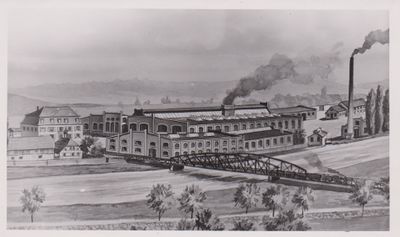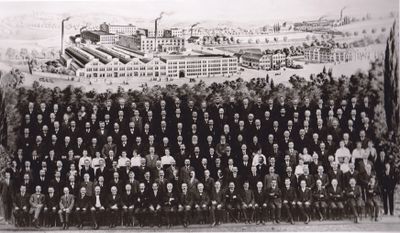Gaggenau/en: Unterschied zwischen den Versionen
(Die Seite wurde neu angelegt: „Ahead of its time“) |
(Die Seite wurde neu angelegt: „==== From chocolate to enamel ====“) |
||
| Zeile 1: | Zeile 1: | ||
<languages/> | <languages/> | ||
Gaggenau Hausgeräte GmbH produces high-quality kitchen appliances with uncompromising standards of quality, authenticity and design. The range includes ovens, combi-steam ovens, Vario special cooking appliances, glass ceramic, gas and induction cooktops, ventilation, vacuuming and warming drawers, cooling appliances, wine climate cabinets, fully automatic espresso machines, dishwashers, microwaves, tumble dryers and washing machines. The Gaggenau brand presents itself today as a luxury brand and is represented by flagship showrooms in leading cities in more than 50 countries around the globe. The company can look back on a long history. It all began in 1683 when Margrave Ludwig Wilhelm of Baden founded an ironworks to make nails and other household goods. He wanted to boost the economy of the local region and open up new sources of income for its people in addition to agriculture. | [[File:1890 Gaggenau Ansicht BSH Konzernarchiv C03-F0147 ca 1890.jpg|thumb|400x400px|The Gaggenau site in 1890. (Source: BSH Corporate Archives)]] | ||
Gaggenau Hausgeräte GmbH produces high-quality kitchen appliances with uncompromising standards of quality, authenticity and design. The range includes ovens, [[Gaggenau combi-steam oven|combi-steam ovens]], Vario special cooking appliances, glass ceramic, gas and [[The CX 480 full surface induction cooktop with TFT touch display|induction cooktops]], [[Gaggenau downdraft ventilation|ventilation]], vacuuming and warming drawers, cooling appliances, wine climate cabinets, fully automatic espresso machines, dishwashers, microwaves, tumble dryers and washing machines. The Gaggenau brand presents itself today as a luxury brand and is represented by flagship showrooms in leading cities in more than 50 countries around the globe. The company can look back on a long history. It all began in 1683 when Margrave Ludwig Wilhelm of Baden founded an ironworks to make nails and other household goods. He wanted to boost the economy of the local region and open up new sources of income for its people in addition to agriculture.<ref>Preface by Michael Wessel, in Theodor Bergmann: Eisenwerke Gaggenau A.G, 1891, New edition, (ed. Michael Wessel) 2009 Rastatt. page 7; for a general chronology of the plant, see pages 79-84; Michael Wessel: Geschichte der Eisenwerke Gaggenau at http://www.murgtal-chronik.de, published 9.4.2012; Ein Blick in die Geschichte Gaggenaus, website of the town of Gaggenau http://www.gaggenau.de/stadtgeschichte.4357.htm; Aus Tradition einen Schritt voraus, Gaggenau website, http://www.gaggenau.com/de/die-welt-von-gaggenau/der-unterschied-heisst/tradition/aus-tradeition-einen-schritt-voraus (last downloaded on 7.12.2016).</ref> | |||
<span id="Seiner_Zeit_voraus"></span> | <span id="Seiner_Zeit_voraus"></span> | ||
Ahead of its time | ==== Ahead of its time ==== | ||
The smithy had a number of tenants in the intervening years of the 18th and 19th centuries. In 1873, the plant was purchased by the entrepreneur Michael Flürscheim from Frankfurt together with Franz Korwan and named "Korwan und Flürscheim Eisenwerke Gaggenau bei Rastatt". However, Korwan left the business again that same year for health reasons. The company was renamed "Michael Flürscheim Eisenwerke Gaggenau".<ref>Michael Wessel: Michael Flürscheim. Industrieller – Sozialökonom – Utopist, Buch & Bild Wessel GmbH, Gaggenau 2014, page 143.</ref> During his time as director, Flürscheim developed the plant to become the first major industrial undertaking in the region, producing a wide range of ironware such as agricultural equipment and tools. Flürscheim established social institutions in his company which were ahead of their time, including a health insurance fund for workers and their families and a consumer association that allowed employees to buy everyday goods cheaply.<ref>Helmut Böttcher: Ein Beitrag zur Stadtgeschichte: Michael Flürscheim - a great entrepreneur and social reformer, who died 85 years ago, 1997 in: Materialien zur Geschichte der Eisenwerke Gaggenau (C03- 0296), BSH Corporate Archives.</ref> The fate of Gaggenau was sealed when Michael Flürscheim came in contact with cooker manufacturer Theodor Bergmann at the Berlin Trade Fair in 1879. Flürscheim was so impressed by Bergmann's eloquence at the stand that he convinced him to come on board with him in Gaggenau. | |||
< | <span id="Von_der_Schokolade_zur_Emaille"></span> | ||
==== | ==== From chocolate to enamel ==== | ||
Bergmann joined the company in 1880. He became a partner in 1884 and the company was renamed "Eisenwerke Gaggenau, Flürscheim und Bergmann". The company's core activities at this stage were heavily focused on the iron foundry, smithy and enameling plant.<ref>Michael Wessel: Michael Flürscheim, page 144.</ref> Bergmann's friendship with the Cologne-based chocolate manufacturer Ludwig Stollwerck proved pivotal at this time. Gaggenau received an order from Stollwerck to produce chocolate and sweet vending machines. Always striving to produce all components internally if possible, the ironworks also produced the enamel signs for the machines. This gave rise to a completely new product sector. Not only did enamel signs for brands such as Stollwerck, Maggi and Odol become a trademark of Gaggenau, the experience with enamel also led to the development of a robust oven enamel.<ref>See Liz Falconer: Gaggenau Fact Sheet, Milton Keynes, 21.09.2012, http://www.gaggenau-press.com/uploads/media/Gaggenau_C_Company_profile_Fact_Sheet_2012_UK.pdf (last downloaded on 7.12.2016).</ref> The recipe for this special enamel formed the basis for the success of its coal and gas stoves. | |||
Bergmann | |||
< | <span id="Stürmische_Zeiten"></span> | ||
==== | ==== Turbulent times ==== | ||
<div lang="de-x-formal" dir="ltr" class="mw-content-ltr"> | <div lang="de-x-formal" dir="ltr" class="mw-content-ltr"> | ||
Version vom 1. August 2023, 09:41 Uhr
Gaggenau Hausgeräte GmbH produces high-quality kitchen appliances with uncompromising standards of quality, authenticity and design. The range includes ovens, combi-steam ovens, Vario special cooking appliances, glass ceramic, gas and induction cooktops, ventilation, vacuuming and warming drawers, cooling appliances, wine climate cabinets, fully automatic espresso machines, dishwashers, microwaves, tumble dryers and washing machines. The Gaggenau brand presents itself today as a luxury brand and is represented by flagship showrooms in leading cities in more than 50 countries around the globe. The company can look back on a long history. It all began in 1683 when Margrave Ludwig Wilhelm of Baden founded an ironworks to make nails and other household goods. He wanted to boost the economy of the local region and open up new sources of income for its people in addition to agriculture.[1]
Ahead of its time
The smithy had a number of tenants in the intervening years of the 18th and 19th centuries. In 1873, the plant was purchased by the entrepreneur Michael Flürscheim from Frankfurt together with Franz Korwan and named "Korwan und Flürscheim Eisenwerke Gaggenau bei Rastatt". However, Korwan left the business again that same year for health reasons. The company was renamed "Michael Flürscheim Eisenwerke Gaggenau".[2] During his time as director, Flürscheim developed the plant to become the first major industrial undertaking in the region, producing a wide range of ironware such as agricultural equipment and tools. Flürscheim established social institutions in his company which were ahead of their time, including a health insurance fund for workers and their families and a consumer association that allowed employees to buy everyday goods cheaply.[3] The fate of Gaggenau was sealed when Michael Flürscheim came in contact with cooker manufacturer Theodor Bergmann at the Berlin Trade Fair in 1879. Flürscheim was so impressed by Bergmann's eloquence at the stand that he convinced him to come on board with him in Gaggenau.
From chocolate to enamel
Bergmann joined the company in 1880. He became a partner in 1884 and the company was renamed "Eisenwerke Gaggenau, Flürscheim und Bergmann". The company's core activities at this stage were heavily focused on the iron foundry, smithy and enameling plant.[4] Bergmann's friendship with the Cologne-based chocolate manufacturer Ludwig Stollwerck proved pivotal at this time. Gaggenau received an order from Stollwerck to produce chocolate and sweet vending machines. Always striving to produce all components internally if possible, the ironworks also produced the enamel signs for the machines. This gave rise to a completely new product sector. Not only did enamel signs for brands such as Stollwerck, Maggi and Odol become a trademark of Gaggenau, the experience with enamel also led to the development of a robust oven enamel.[5] The recipe for this special enamel formed the basis for the success of its coal and gas stoves.
Turbulent times
Zur Jahrhundertwende wird die Produktpalette deutlich reduziert. Das Werk spezialisiert sich auf Fahrräder – das beliebte Badenia Modell verkauft sich zwischen 1880 und 1908 250.000 Mal[6] – sowie Gasherde und Gaskocher. Während des Ersten Weltkrieges stellt die Produktion ganz auf Kriegsmaterial um. Nach dem Krieg erholen sich die Geschäfte zunächst wieder. Doch Inflation und Wirtschaftskrise Ende der 1920er Jahre führen schließlich zur Stilllegung des Werks.
1931 wird die Firma neu gegründet[7] und von Otto von Blanquet übernommen. In dieser Zeit wird der erste elektrische Herd von Gaggenau entwickelt, ein weiterer wichtiger Schritt auf dem Weg zum Herd- und Backofenspezialisten. Nachdem am 10. September 1944 ein Bombenangriff einen Großteil der Werksanlagen zerstört, wird die Fabrik in den Nachkriegsjahren zunächst wieder aufgebaut. Danach geht es weiter aufwärts: Im Zuge der Währungsreform 1948 und des darauffolgenden „Wirtschaftswunders“ erweitert und modernisiert die Firma ihr Produktangebot. Dr. von Blanquet entwickelt weiterhin Backöfen – allerdings einen neuen Ofentyp. Die überarbeitete Konstruktion verbraucht weniger Kohle und Gas („Kohle- und Gas-Sparherde“) und bringt Gaggenau somit den Ruf einer ökonomischen Alternative ein. Mit der zunehmenden Beliebtheit von Elektrobacköfen werden auch die elektrischen Varianten der sparsamen Backöfen sowie die elektrischen Heiz- und Lüftungssysteme immer populärer. So zieht Gaggenau in viele neue Küchen des wiederaufgebauten Europas ein.
Aus Liebe zum Kochen
Ab 1956 wird Gaggenau von Ottos Sohn Georg von Blanquet geführt. Er ist ein leidenschaftlicher Koch und er hat eine Vision: Maßgeschneiderte Einbauküchen mit technisch hochentwickelten, einfach zu bedienenden Geräten. Diese Vision verfolgt er konsequent und allen Schwierigkeiten zum Trotz. Dabei profitiert Georg von Blanquet von der boomenden kulinarischen Kultur und der neuen Wertschätzung von Küchengeräten in der Nachkriegszeit. Seine Ideen sind nicht nur für Gaggenau richtungsweisend, sondern auch für die ganze Branche. Er ebnet der revolutionären Einbauküche den Weg, baut 1956 den ersten Einbaubackofen auf Augenhöhe ein und bringt die ersten separaten Kochfelder und Lüftungsgeräte auf den Markt. Als Koch weiß er sein Unternehmen dazu zu nutzen, die Bedürfnisse von Profiköchen zur Herausforderung für Ingenieure zu machen.
1962 wird das gesamte Werk auf das Areal der früheren Gaggenauer Glashütte verlegt. Es werden erstmals Küchenlüftungsgeräte produziert. Dies führt 1976 beispielsweise zur Entwicklung der ersten Muldenlüftung mit Abzug direkt am Kochfeld nach unten.
Um sich der immer größer werdenden Konkurrenz in Deutschland zu stellen, versucht man den Betrieb im Ausland auszubauen, indem man dort Tochterfirmen erwirbt.[8]
Trotz Expansion bleibt es schwierig für Gaggenau, im internationalen Wettbewerb zu bestehen. Zum Jahreswechsel 1994/95[9] wird Gaggenau von der Bosch-Siemens Hausgeräte GmbH übernommen. Diese verlagert die gesamte Produktion und Entwicklung nach Lipsheim im Elsass und unterzieht die Firma einer Restrukturierung.[10] Die Marke Gaggenau gilt heute als Innovationsführer für Technologie und Design „Made in Germany“. – „Der Unterschied heißt Gaggenau“.
Notes
- ↑ Preface by Michael Wessel, in Theodor Bergmann: Eisenwerke Gaggenau A.G, 1891, New edition, (ed. Michael Wessel) 2009 Rastatt. page 7; for a general chronology of the plant, see pages 79-84; Michael Wessel: Geschichte der Eisenwerke Gaggenau at http://www.murgtal-chronik.de, published 9.4.2012; Ein Blick in die Geschichte Gaggenaus, website of the town of Gaggenau http://www.gaggenau.de/stadtgeschichte.4357.htm; Aus Tradition einen Schritt voraus, Gaggenau website, http://www.gaggenau.com/de/die-welt-von-gaggenau/der-unterschied-heisst/tradition/aus-tradeition-einen-schritt-voraus (last downloaded on 7.12.2016).
- ↑ Michael Wessel: Michael Flürscheim. Industrieller – Sozialökonom – Utopist, Buch & Bild Wessel GmbH, Gaggenau 2014, page 143.
- ↑ Helmut Böttcher: Ein Beitrag zur Stadtgeschichte: Michael Flürscheim - a great entrepreneur and social reformer, who died 85 years ago, 1997 in: Materialien zur Geschichte der Eisenwerke Gaggenau (C03- 0296), BSH Corporate Archives.
- ↑ Michael Wessel: Michael Flürscheim, page 144.
- ↑ See Liz Falconer: Gaggenau Fact Sheet, Milton Keynes, 21.09.2012, http://www.gaggenau-press.com/uploads/media/Gaggenau_C_Company_profile_Fact_Sheet_2012_UK.pdf (last downloaded on 7.12.2016).
- ↑ Wessel: Michael Flürscheim, S. 146.
- ↑ Geschichte der Eisenwerke Gaggenau GmbH in Stichworten (Stadtarchiv Gaggenau), Materialien zur Geschichte der Eisenwerke Gaggenau, BSH-Konzernarchiv, C03-0296.
- ↑ Geschichte der Eisenwerke Gaggenau GmbH in Stichworten.
- ↑ BSH-Konzernarchiv, A01-0012, Geschäftsbericht 1994, S. 6.
- ↑ Die Historie von Gaggenau (BSH Präsentation), Materialien zur Geschichte der Eisenwerke Gaggenau, BSH-Konzernarchiv, C03- 0296, Folie 3.

